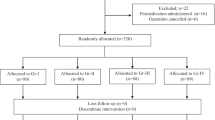Abstract
Intravenous lidocaine (1.5 mg·kg−1) was not effective in attenuating the circulatory changes and the cough reflex induced by airway stimulation during recovery from general anesthesia, whereas endotracheal 4% lidocaine (3 ml) was effective. The arterial concentration of the intravenously administered-lidocaine peaked at a level of 9.52±0.81μg·ml−1 0.5 min later. The arterial concentration of the endotracheally administered-lidocaine peaked at 1.44±0.13μg·ml−1 15 min later. These findings indicate that the endotracheal administration of lidocaine may be superior to the intravenous administration for attenuating the circulatory changes and the cough reflex during recovery from general anesthesia, and that the arterial concentration of lidocaine did not correlate with the clinical efficacy for this purpose.
Similar content being viewed by others
References
Burstein CL, Lopinto FJ, Newman W: Electrocardiographic studies during endotracheal intubation. 1. Effects during usual routine technics. Anesthesiology 11:224–237, 1950
Wycoff CC: Endotracheal intubation: Effects on blood pressur and pulse rate. Anesthesiology 21:153–158, 1960
Tomori Z, Widdicombe JG: Muscular, bronchomotor and cardiovascular reflexes elicited by mechanical stimulation of the respiratory tract. J Physiol 200:25–49, 1969
Dohi S, Gold MI: Pulmonary mechanics during general anesthesia: The influence of mechanical irritation on the airway. Br J Anaesth 51:205–214, 1979
Abou-Madi MN, Keszler H, Yacoub JM: Cardiovascular reactions to laryngoscopoy and tracheal intubation following small and large intravenous doses of lidocaine. Can Anaesth Soc J 24:12–19, 1977
Hamill JF, Bedford RF, Weaver DC, Colohan AR: Lidocaine before endotracheal intubation: Intravenous or laryngotracheal? Anesthesiology 55:578–581, 1981
Denlinger JK, Ellison N, Ominsky AJ: Effects of intratracheal lidocaine on circulatory responses to tracheal intubation. Anesthesiology 41:409–412, 1974
Stoelting RK: Blood pressure and heart rate changes during short-duration laryngoscopy for tracheal intubation: Influence of viscous or intravenous lidocaine. Anesth Analg 57:197–199, 1978
Steinhaus JE, Howland DE: Intravenously administered lidocaine as a supplement to nitrous oxide thiobarbiturate anesthesia. Anesth Analg 37:40–46, 1958
Steinhaus JE, Gaskin L: A study of intravenous lidocaine as a suppressant of cough reflex. Anesthesiology 24:285–290, 1963
Poulton TJ, James III FM: Cough suppression by lidocaine. Anesthesiology 50:470–472, 1979
Grossmann JI, Cooper JA, Frieden J: Cardiovascular effects of infusion of lidocaine on patients with heart disease. Am J Cardiol 24:191–197, 1969
Author information
Authors and Affiliations
About this article
Cite this article
Okuda, M., Furuhashi, K., Konishi, K. et al. Effects of intravenous or endotracheal lidocaine on circulatory changes during Recovery from general anesthesia. J Anesth 4, 331–336 (1990). https://doi.org/10.1007/s0054000040331
Received:
Accepted:
Issue Date:
DOI: https://doi.org/10.1007/s0054000040331




